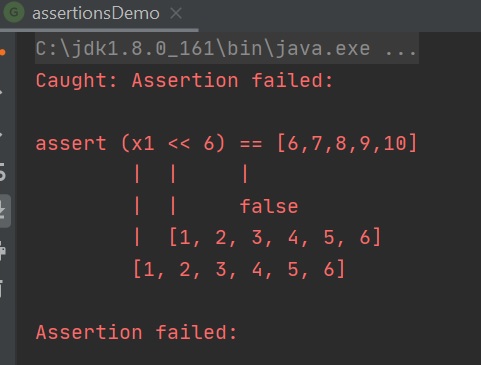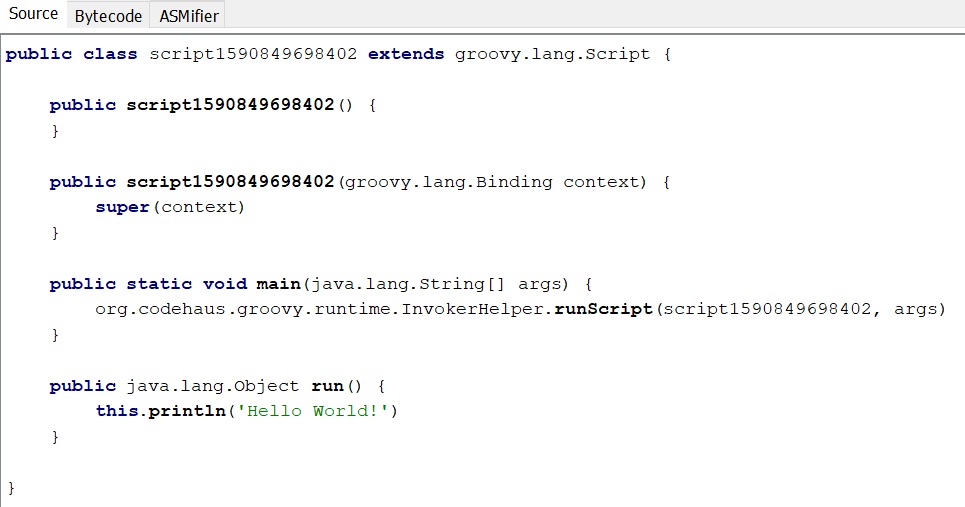In this section I am going to cover the basics like imports, keywords, comments, assertions, scripts classes and numbers.
Groovy by default imports a number of packages, the reason is that many of the common classes are used and thus this reduces boilerplate code for example you dont have to type System.out.println(...) and instead can use println(...)
| Default imports | import java.lang.* import java.util.* import java.io.* import java.net.* import groovy.lang.* import groovy.util.* import java.math.BigInteger import java.math.BigDecimal |
| Single and Star imports | import groovy.xml.MarkupBuilder // single import import groovy.xml.* // star import |
| Static import | import static Boolean.FALSE // static import |
| Import aliasing | import java.sql.Date as SQLDate // use an alias SQLDate sqlDate = new SQLDate(1000L) // now you can use either Date or SQLDate (alias) import static Calendar.getInstance as now // you can use aliasing with static imports as well assert now().class == Calendar.getInstance().class |
As with other programming lanuages Groovy has many keywords that cannot be used as a variable, method or class name.
| Keywords/Reserved words | abstract, as, assert, boolean, break, byte, case, catch, char, class, const, continue, def, default, do, |
Some of the comments in Groovy are the same as in Java, there are two extra ones related to Groovy. Make sure you don't go overboard with comments only add them if it would help the next developer.
| Single-line comment | // This is a single-line comment |
| Multi-line comment | /* This is a multi-line comment which can expand multiple lines :-) */ |
| Groovy Doc comment | /** * This is a comment * for Groovy documentation * and can expand multiple lines */ |
| shebang comment | #!/usr/bin/groovy // same as other linux scripting shebang |
Assertions can be used to test your program, you assume a value and you can test for that value in your code to make sure everything is working correctly, if the assert is not true then you get a failed error message.
| Assert example | // you must provide an assertion an expression that evaluates to true assert true // we can provide a full expression on the right hand side // note that unlike Java and more like Ruby or Scala == is equality assert 1 == 1 // like the example above we are evaluating an expression def x = 1 assert x == 1 // The power assertion statements true power unleashes in complex Boolean statements, // or statements with collections or other toString-enabled classesDemo: def x1 = [1,2,3,4,5] assert (x1 << 6) == [6,7,8,9,10] Note: below is what a failed assert looks like in intellij  |
Groovy appears to be a scripting language like Python or Perl, however its much more, but you can create a groovy file and add a shebang and will will run like a script, but groovy scripts are compiled into a class, but when looked into via AST browser lots of code (including a main method) has been added to make it work with the JVM.
| Groovy script | #!/usr/bin/groovy println "Hello World!" Note: below is the compiled code looking via a the Groovy console AST browser  |
Classes basics are that they have properties, methods the same as Java, in Groovy the filename does not have to have the same name as the class, if you have multiple classes in a file then when compiled three .class files will be created just like Java.
Onething to note is that if you add anything other than just the class the file becomes a script and you might get an error duplication of class this is because the scripting code gets compiled into a file called Developer.class the same as the Developer class you have coded. // to get around this problem you must either rename the the file different from the // class above or rename the class above
| Class basics | // No need to have the filename the same as the class name
// You can have multiple classes in one file
// Three .class files will have three separate classes
class AngryBirds {
}
class Bird {
}
class Pig {
} |
| Class example | Developer.groovy
--------------------------------------------------------------------------------------------
class Developer {
String firstName
String lastName
// def means any type
def languages = [] // ArrayList
void work(){
println "$firstName $lastName"
}
}
// anything here would be a script but we get an error
// duplication of class this is because the below code get compiled into a file
// called Developer.class the same as the class above
// to get around this problem you must either rename the the file different from the
// class above or rename the class above
//def dev1 = new Developer("Lorraine", "Valle")
//println dev1
AppDevloper.groovy
--------------------------------------------------------------------------------------------
Developer d = new Developer()
d.firstName = "Paul"
// getter and setter methods are automatically created for all member variables
d.setLastName("Valle")
// def keyword means any type
println d.languages.class
d.languages << "Groovy"
d.languages << "Java"
println d.languages // uses default toString
d.work() |
Numbers in Groovy are all wrapper object classes Integer, Float, Double, BigDecimal or Boolean
| Numbers in groovy | // In groovy primitive types they are autoboxed to the equivalent type object println 1234.getClass().getName() // java.lang.Integer int x = 1 println x.class // Integer Object def y = 5.9876f println y.class // Float Object def z = 5.05d println z.class // Double Object boolean a = true println a.class // Boolean Object |
In Groovy you have the following
- Conditional - if, if else, if else-if else and switch
- Looping - while, for and closures
- Exceptions - try-catch block
The if and switch statements are the same in other programming languages, see examples below
| if, else statement | if( false ) {
println "true"
} else {
println "false"
} |
| if, else-if, else statement | def someage = 37
if( someage >= 21 && someage < 35 ) {
println "buy some beer"
} else if( someage >= 35 ) {
println "run for president"
} else {
println "under 21..."
} |
| switch statement | def num = 12
switch( num ) {
case 1:
println "1"
break
case 2:
println "2"
break
case 1..3:
println "in range 1..3"
break
case [1,2,12]:
println "num is in list [1,2,12]"
break
case Integer:
println "num is an Integer"
break
case Float:
println "num is a float"
break
default:
println "default..."
} |
Loops in Groovy are again the same in as in other programming languages, see some examples below
| while loop | // while
List numbers = [1,2,3]
while( numbers ) { // while there is a number in numbers
// do something
numbers.remove(0)
} |
| for-in loop | List nums = [1,2,3]
for( Integer i in 1..10 ) {
println i
}
for( i in 1..5 ) {
// Do something
}
for( String s in 'a'..'z' ){
if( s == 'a') continue
println s
if( s > 'b' ) break
} |
| Closure | def list = [1,2,3,4,5]
list.each { println it } |
For exceptions you have the traditonal try-catch block
try {
foo()
} catch( Exception e ) {
log << e.message // same as e.getMessage()
} finally {
log << 'finally'
}
println log
// Java 7 introduced a multi catch syntax
try {
// do stuff
} catch( FileNotFoundException | NullPointerException e ) { // notice only one |
println e.class.name
println e.message
} |
AST (Abstract Syntax Tree) transforms allows us to hook into the Groovy compilation process and customize it to meet our needs, an annotation is an AST transformation. Annotations in Groovy are the same as in Java, if you have not used annotations before, Annotations are a form of metadata wherein they provide data about a program that is not part of the program itself. Annotations have no direct effect on the operation of the code they annotate, they are used for, we can also use the built-in ones
- Compiler information - can be used by the compiler to detect errors or suppress warnings
- Compile-time and deployment-time processing - Software tools can process annotation information to generate code, XML files, and so forth
- Runtime processing - are available to be examined at runtime
Here are a few annotation examples but there are many more, see the Groovy documentation for a list of all annotations
| Annotation example | @ToString(includeNames = true, excludes = ["email"]) // create a method called toString but exclude email
class Person {
String first
String last
String email
}
@Canonical // toString, tuple and equals combined into one)
@Sortable( includes = ['last', 'first'] ) // sort in the order of last then first
class Person {
String first
String last
}
@Singleton // singleton annotation
class DatabaseConnection {
} |
Groovy has many operators incluide ones that are specific to the Groovy
| Arithmetic | assert 10 + 1 == 11 assert 10 - 1 == 9 assert 10 * 2 == 20 assert 10 / 5 == 2 assert 10 % 3 == 1 assert 10 ** 2 == 100 |
| Binary | // += -= *= /= %= **= def a = 10 a += 5 // a = a + 5 assert a == 15 |
| Relational | assert 1 + 2 == 3 assert 3 != 4 assert -2 < 3 assert 2 <= 2 assert 3 <= 4 assert 5 > 1 assert 5 >= -2 |
| Logical | assert !false // logical NOT assert true && true assert true || false |
| Ternary | String s1 = "" result = ( s1 != null && s1.length() > 0 ) ? 'Found' : 'Not Found' |
| Elvis | class User {
String name
}
def user = new User(name: 'Paul Valle')
displayName = user.name ? user.name : 'Anonymous'
displayName = user.name ?: 'Anonymous' // short-hand of above |
| Safe Navigation | // Java Code
Person2 p = new Person2()
if( p.address != null ) { // in groovy use p?.address
Address address = p.address
address.first = "1234 Main"
}
// Groovy Code
def address = p?.address // is the same as the !=
assert address == null |
Grape is a jar dependancy manager in Groovy, Grape (The Groovy Adaptable Packaging Engine or Groovy Advanced Packaging Engine) is the infrastructure enabling the grab() calls in Groovy, Grape will, at runtime, download as needed and link the named libraries and all dependencies forming a transitive closure when the script is run from the selected repository.
If the dependancy has already been pulled down then it won't do it again.
// Grape example
@Grapes(
@Grab(group='org.apache.commons',module = 'commons-lang3', version = '3.4')
)
// Import a specific version of JdbcTemplate
@Grab(group='org.springframework', module='spring-orm', version='3.2.5.RELEASE')
import org.springframework.jdbc.core.JdbcTemplate
// short-hand of above
@Grab('org.springframework:spring-orm:3.2.5.RELEASE')
import org.springframework.jdbc.core.JdbcTemplate
// Using Maven central as a repository
@GrabResolver(name='restlet', root='http://maven.restlet.org/')
@Grab(group='org.restlet', module='org.restlet', version='1.1.6') |